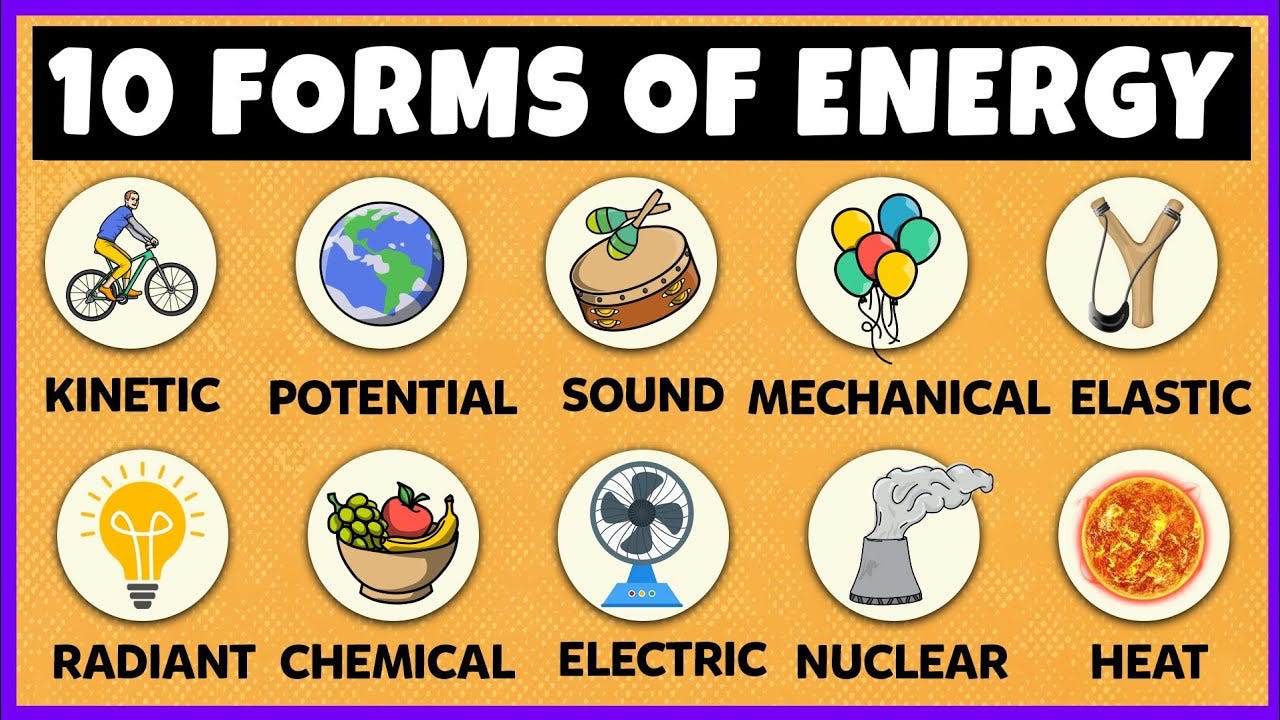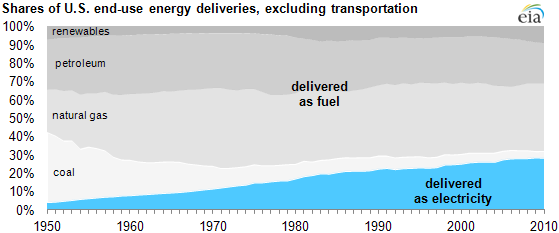The Energy Basics: So, How Do the Lights Turn On? (Part 1)
A beginner’s guide to understanding electricity, utilities, and the grid
Posted From: New York, New York, United States
Introduction Energy Series: Article 1
Topics covered:
Units of energy and electricity
Energy's importance through history and today
Value chain of the electric industry
Regulatory compact
Units of energy and electricity
Energy.
When we say I have "energy," what does that mean?
In a scientific sense, energy is the capacity to do work. It comes in many forms:

For example, we have all heard of "calories" before. They are a unit of measurement for the capacity to do work. Standard units of energy are joules (J), kilojoules (kJ), and calories (cal). One joule is the energy transferred when applying a force of 1 newton over 1 meter. A kJ is 1,000 J and is commonly found in non-US food labels. A calorie is equivalent to 4.184 J.1 2
Electric energy is one form of energy that comes from the movement of electric charges. It can be converted to or from other types of energy. Electricity is how that energy moves through a system.
Nuclear energy is a form of energy itself. In nuclear power stations, the nuclear energy is converted to heat energy, then to mechanical energy, and then to electric energy
Fossil-fuel based power plants convert heat energy to mechanical to electric
Hydroelectric & wind converts kinetic to mechanical to electric
Solar PV converts radiant / light to electric
Electric energy can be measured with the following units; the water pipe analogy really helped me understand the units of electricity
Volts (V)
Potential for energy to move = water pressureAmpere / Amps (A)
Current (rate of energy flow) = pipe size
Ohm (Ω)
Resistance to current = narrowness in the pipe
Watts (W)
Power (rate of energy use) = flow rate
Kilowatt (kW)
1,000 Watts
Kilowatt Hour (kWh)
“Energy” = Power (kW) x time (hours) = water consumed over time
For context, average power use in NYC is ~6,000 MW (6 GW, or 6,000,000 kW) and peak power use is roughly double that.3
Energy's importance through history
History of Electricity and Humans
Electricity is a relatively new form of energy that humans have harnessed.4
The world's first commercial electric power plant is 1 mile from my apartment in NYC. At 255 Pearl Street, Thomas Edison's company built a coal power plant in the heart of the now "Financial District" in NYC.5
In the beginning of the 1900s, electricity was like the AI industry of today: money and ideas poured in to own the business that would be a critical component of the future.6
Dozens of companies jumped at the opportunity to sell electricity to new customers.
Want indoor lights that do not burn fuel?
Want air conditioning?
Want to keep your food fresh?
Electricity provides all of those solutions!
In those early years, fierce competition led to inefficient systems. Cities, like the picture below of Manhattan, were tangled in a web of competing wires from multiple providers.7 This duplication of infrastructure massive drove up costs for customers; if you wanted to switch provider, you had to have a new distribution hookup.
Major events in the history of the electric industry in the US have included:
1882 - Creation of the Pearl Street Power Plant (mentioned above)
1935 - Passing of the Public Utility Holding Company Act of 1935 (“PUHCA”) - major legislation designed to regulate utilities
1950-60s - Growth of centralized power plants (i.e., large scale fossil fuel and nuclear power plants) to serve increased demand by customers (specifically, industrial production, air conditioning)
1970s - US energy crises (oil shocks cause a decline in oil power plants)
1990s - Market restructuring (partial deregulation of electricity market - to be discussed in a future article)
2000s and today - growth of DERs, smart grids, and electrification
Every year, electricity is increasing as a share of energy use by humans.8

For example:
EVs use electricity instead of gasoline
Electric heat replaces heating from gas, oil, or wood.
The trend is clear: electricity is growing as a share of total energy use.
What does that mean for the electric industry today?
Today, the electricity industry faces a consumer-led, technology-led energy transition.
We are experiencing the birth and growth of distributed energy systems across both physical and digital realms.
Physically, the deployment of EVs, solar, lithium-ion batteries, heat pumps, and other grid edge devices are rapidly increasing.
Digitally, these pieces of equipment offer customers and companies loads of data and control through IoT-based solutions and digital interfaces.
❓ What’s one way you’ve experienced a change in energy being used?
For me, I recently took a road trip out west. The form of transport I used while out there was not oil-based, but instead, electricity-based: my friend and I traveled over 1,500 miles in an EV.9
Value chain of the electric industry: making sense of business activities
Electric utilities operate with numerous different sets of constraints: science, business, and law. We've already explored the scientific underpinnings; now, we will discuss the business and law factors.10
The electric industry has traditionally three core components of its value chain: generation, transmission, and distribution.11
Generation: creating electricity in large, centralized power plants
Transmission: moving electricity long distances via high voltage lines
Distribution: delivering electricity to the end use customer12
There are over 12,500 power plants, 500,000 miles of transmission, and over 5 million miles of distribution in the US. If any part of this value chain fails, the lights do not turn on.
So, when the lights actually do not turn on, what part of the value chain is at fault?
The vast majority of power outages, over 95%, are due to issues with the distribution system.
These weather-based events are increasing in frequency and intensity.13
Law: the "regulatory compact" governing utilities
In exchange for a monopoly on providing electricity within a geographic area, the utility agrees to serve all customers reliably and at reasonable rates. In return, the utility is allowed to recover its costs and earn a fair rate of return, as determined by state regulators.
The regulatory compact aims to strike a balance between protecting the public interest through reasonable rates and service quality while ensuring that utilities can make a fair return on their investments, which is essential for attracting capital and maintaining a stable energy supply.14
Today, utilities make money based on this regulatory compact through cost of service regulation (to be examined in-depth in a future article in this series).
The compact was designed for a centralized, one-way electricity system.
There are numerous pros for this system: widespread service to all customers, reliable electricity, consumer protection, and simplified operations. However, as the electricity industry faces a "consumer-led, technology-led energy transition," this centralized system is oftentimes more costly to distributed options and slow to respond to the dynamic changes occurring in today’s world. For instance, how large, AI datacenter loads can be served in a reasonable time.
Increasing energy use has formed the basis of human progress; electricity is now one of our most important forms of energy. The regulatory compact helped build a reliable, universal electric system, but it was not designed for today’s dynamic, decentralized, and decarbonized grid. As DERs rise, this compact is being tested.
Next in the series: How utilities are planning for generation, transmission, and distribution in a rapidly changing world, while maintaining reliability, resiliency, and affordability.”
This is post 8 on Energy at the Edge.
Views expressed in this article are those of the author and do not necessarily represent the views of their place of employment.
AI was not used for writing.
What we see on US food labels are actually kilocalories (kcal), so, 4,184 J.
If you want to dive deeper, I recommend Vaclav Smil's book titled "Energy and Civilization." In it, he describes the relationship between energy's potential for work and human's harnessing of work from various sources and for various activities over time.
Peak power was 11,822 MW on July 16, 2024; ConEd forecasts peak power of 12,610 MW in 2025, a 6.7% increase! Annual energy use is ~52,000,000 MWh = ~6,000 MW x 365 days x 24 hours/
Famously, Benjamin Franklin tied a key to a kite to demonstrate the potential of lightening to convey electricity as an energy form.
It used direct current (DC) to transfer electricity, as opposed to the now common alternating current (AC). Fun fact: the location is across the street from the coolest city-pickleball court I have played at!
With foresight, we see electricity does indeed underpin our lives; I propose the same will be true of AI.
In the Great Blizzard of 1888, all wires had to be buried, so pictures of competing wires became harder to see above-ground.
For a deeper dive, I recommend reading about the difference between ways to measure energy, from primary, secondary, final, to useful.
We even made it through the charging desert of Wyoming! If you are interested in a reflection of this journey, I am posting a video of this to my personal substack tomorrow.
We will explore the preliminary principles of the operations of the electric grid in the next posts of this series.
Historically, electric utilities have had ownership over all parts of the value chain. In the past few decades, "deregulation," which will be explored in a future post in this series, has forced electric utilities to relinquish ownership of generation, and sometimes, transmission.
Very large customers may connect directly to the transmission system, but this is rare.
To explore further in a future article.
This frameworks comes from PUCHA and subsequent regulation. The act gave authority to regulate, license, and break up electric utility holding companies that existed across state lines, and thus, allowed state regulation to guide utility actions.








Any tips on getting through Smil ... I've been meaning to finish Energy & Civilization 😂?